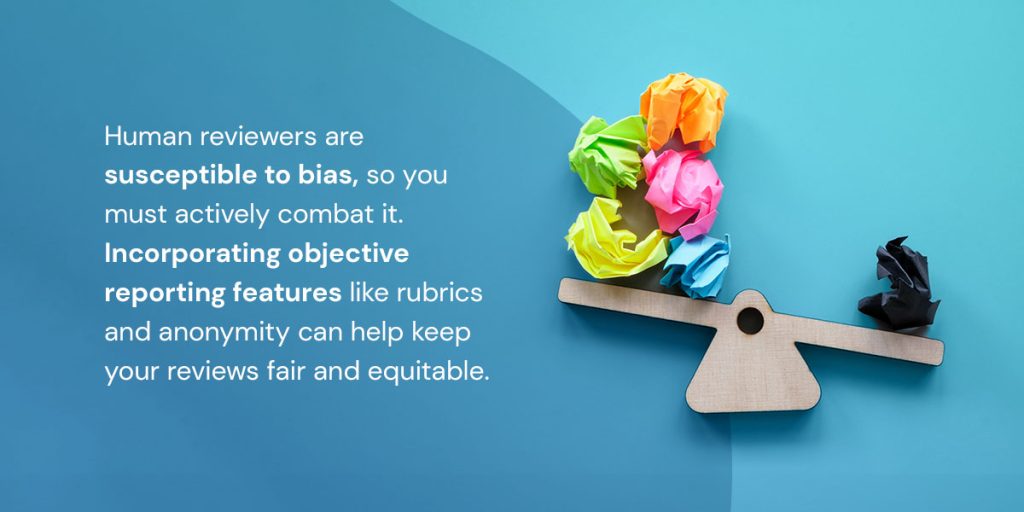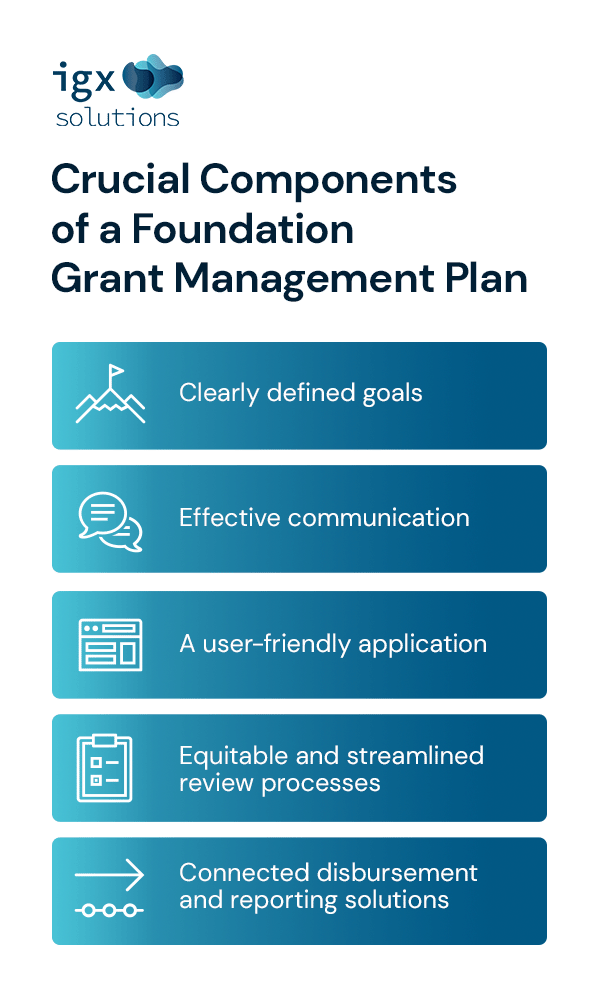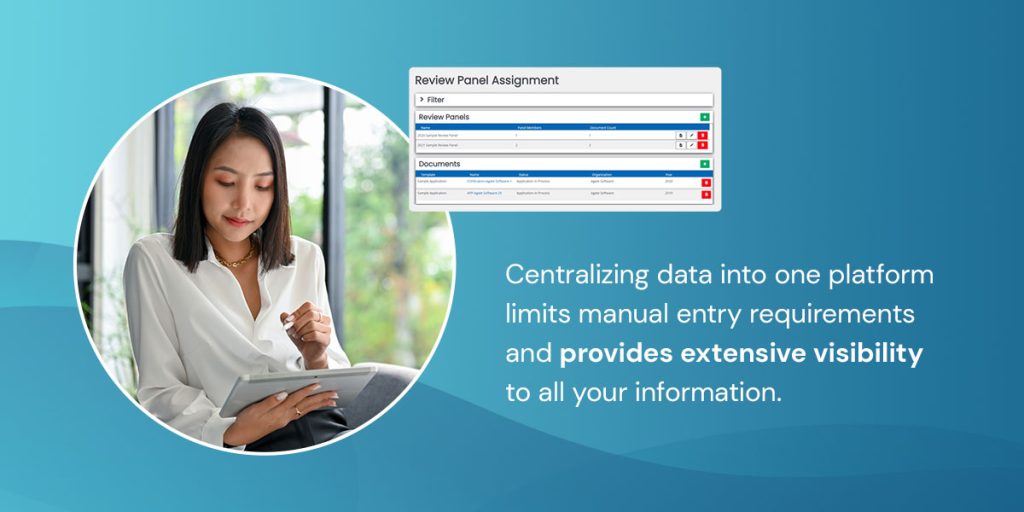
Table of Contents
When your foundation grants funds, you have the opportunity to make a significant difference toward your cause — but only if you can effectively disburse awards to deserving, well-aligned and effective grantees. A poor grant management process frequently leads to inefficiencies and frustrations for both the foundation and grantees.
If you award grants, you need robust grant management software for foundations that facilitates a smooth process at every step, from outreach to reporting. To help you build that strategy, we’ve created a guide to grants management for foundations, complete with common problems and best practices for maximizing the value of your awards.
Foundation grant management challenges can come from many areas, ranging from slow or biased assessment processes to ineffective outreach campaigns. They hurt the foundation, the grant seeker and, ultimately, the cause you’re trying to support.
A stronger approach to grant management can help organizations combat common problems like costly administrative processes or a lack of qualified applicants. Some of the ways your tactics can help include:
Many of these challenges overlap with each other — but so do their solutions. For example, adding a quick eligibility screener could help you increase the number of qualified applicants while reducing administrative demands. Your team would only work with potential recipients, limit unnecessary work for grant seekers and reduce questions from organizations asking about eligibility.

As you build or update a grant management plan, ensure you have the following elements. They can help you address some of the most common difficulties associated with grant management for foundations.
Start by zeroing in on your mission and fleshing it out with specific information about how it relates to the grants you will award. Create a defined goal for your grant program. Emphasize the general purpose of the funds and what qualities you want grant recipients to embody. If you host multiple grant programs, create goal statements for each.
These statements guide your decision-making throughout grant management, providing clear direction for your team and applicants. Your team might use it to make tough decisions about applicants, and your grant seekers can use it to adjust their application for your foundation. If a grant seeker doesn’t align with your goals, a clear statement can help them see that upfront and prevent any wasted time.
With strong communication at all stages of grant management, you can provide better transparency and improve experiences for grant seekers and recipients. Explore your communication in these areas:
Look for groups and connections that can help you reach your ideal grantees. Consider a campaign on social media, and include multi-lingual applicants in your outreach. Information sessions are also a great way to reach potential grant seekers. Make sure you can support these new visitors with, for example, an application form in multiple languages. Provide plenty of information when they reach you.
If grant seekers have questions, make it easy for them to reach you. Include confirmations where appropriate, such as after uploading documents or submitting the application. An easy-to-use website can be particularly helpful and help minimize calls about technical issues, but you should still have team members ready to assist if needed.
Make your selection process transparent with plain language about eligibility requirements and scoring methods. Tell applicants what to expect in the next steps, including how you’ll contact them and when they might receive a response.
Once you’ve chosen your grantees, communicate the results to everyone, even those not selected. Inform your recipients of future requirements and processes, like how they’ll submit documents and receive funding.
Explore the messages you use to communicate these details and how you get them to grant seekers and recipients. If they aren’t reaching people or you spend too much time answering basic questions, it may be time to revisit your communication tactics. Consider your website, social media tactics and emails. Transparency and easy access to information can effectively streamline grant management.

The application process is time-consuming for many organizations, eating into limited labor resources, but you can speed it up by simplifying forms and requirements and providing intuitive design.
Consider what information is essential to making a decision. Your main questions will likely ask about:
Try to narrow extra questions down to only the necessities. You could also create a shorter first-round application and ask applicants to answer more questions or ask for documentation in a second round.
Simplifications like these show grant seekers that you value their time and can facilitate an effective partnership. If you offer a smooth application, you’ll likely have smooth reporting processes, too. They help both parties focus on reaching their missions and limit the potential for confusion.
Another important element of your application is its design. Ensure your application experience is easy to use, visually appealing and accessible to users with different abilities. Also, automatically connecting data from the application to your grant management software can help reduce back-end administration requirements like copying over data.
Unbiased, equitable reviewing is the cornerstone of a fair grant program. Some elements you’ll need include:
Consider their identities, expertise and perspectives. Focus on creating an environment where reviewers can speak up and make their voices heard, allowing you to foster inclusivity more effectively.
Determine how your team will handle different stages of the review process, such as verifying eligibility or scoring. Establish a minimum number of reviewers to look over each application, which can help reviewers stay consistent and create a balanced workload. Consider whether some applications should go to reviewers with expertise in certain subjects.
Implement efficient, systematic scoring strategies to guide reviewers in the right direction and prevent biases from impacting results. One popular option is to use a rubric in which reviewers assign points for various elements present in the application. Other methods include point scales, detailed reports and interviews. Consider sharing your scoring process with applicants to provide transparency and help them succeed. For example, the National Institutes of Health offers in-depth guidance on scoring for grant seekers with information on each criterion.
Addressing bias requires proactive behaviors, such as standardized scoring and team training. Other methods might include anonymizing information in early rounds and making some demographic details optional. Make your plan explicit by writing it up. You could even publicize it. Sharing your commitment to reduce bias can build trust in your organization and help you achieve more equitable granting practices.
Along with inclusive and anti-bias scoring, your review process should be efficient. Delays in the review process often come from technology issues, such as extensive manual processes. For example, your team might spend considerable time verifying data and scanning paper forms instead of scoring applications or writing critiques. Streamlined grant management technology can reduce or eliminate many of these requirements, leaving more time for higher-value tasks.
Automation and data centralization are two crucial components of an efficient grant review process. Consider implementing a solution that can automatically send applications to the next stages with minimal human involvement. For instance, if someone applies on your website, you can link the information directly to a grant management platform rather than waiting for someone to copy the data manually. This platform also puts all your application data in one place so everyone can access the same information and avoid redundancy.
Look for grant management software for foundations that offers workflow automation and integrates with external data sources, like SAM.gov or address validation. The right program can also support your review process with additional tools like self-service options for applicants and risk assessment features.
Once you’ve chosen your recipients, set yourself up for success during the reporting and evaluation stages. Remember, grant management is labor, and too much of it can prevent your grantees from doing the important work you want to support. Streamlined processes can reduce the administrative burden of reporting for both parties.

Start by giving grantees an easy way to upload additional documentation or payment information, and link the data to your grant management program. Many foundations collect performance progress reports about the status of a project to understand how the funds are used. Simplify these reports as much as possible while collecting the necessary information, and look for areas to consolidate, such as collecting reporting data during a site visit rather than requiring the grantee to submit another form.
While minimizing work for grantees, easy data submission also limits administrative requirements for the foundation. Your team can avoid chasing down information and manually entering it into your grant management software.
When it’s time to turn your data into insights, a connected system can pull information from your grant management program and generate reports. These findings can help you evaluate success and find areas for improvement. Centralizing data into one platform limits manual entry requirements and provides extensive visibility to all your information.
Some helpful solutions to consider in the reporting phases include:
Having a great strategy helps immensely, but you’ll also need to understand the impact of grant management on other processes and put your goals front and center. Keep these grant management best practices in mind to optimize your strategy:
Support your DEI efforts by ensuring your program reaches the right people. Actively include people from all backgrounds in your marketing. Talk to existing members from different backgrounds, and consider launching targeted social media strategies.
Drastically speed up your processes and improve accuracy by automating them. Creating hands-off workflows allows you to focus your team’s precious time on tasks that require human involvement, like scoring.
Keep your team connected throughout grant management with regular meetings, updates and collaboration tools.
Understand your precise requirements from the start and incorporate them into your processes. For example, if federal reporting requirements demand information on the size of organizations, you can ask for it in your initial application.
Keep track of all communication with grant seekers and recipients and create a plan to ensure engagement. Strong relationships can foster trust, further progress on shared goals and encourage grantees to return for annual awards.
Whatever shape your grant management takes, a good strategy and powerful tools are crucial for making as much progress as possible toward achieving your mission.

A strong approach to foundation grant management can determine your ability to disburse funds fairly and efficiently while supporting your foundation’s goals. Try the tips outlined in this grant management guide to improve your strategy.
To facilitate many of the tasks we’ve discussed, you’ll need software designed for the grant awarding process. IGX Solutions offers grant management software for foundations, complete with tools and resources to address the unique challenges of this environment. You can streamline your workflows, centralize applicant data, create an exceptional applicant experience, and unlock insights with powerful reporting. The IntelliGrants IGX platform provides robust personalization to tailor the experience to your processes.
Book your demo today to see IntelliGrants IGX in action.